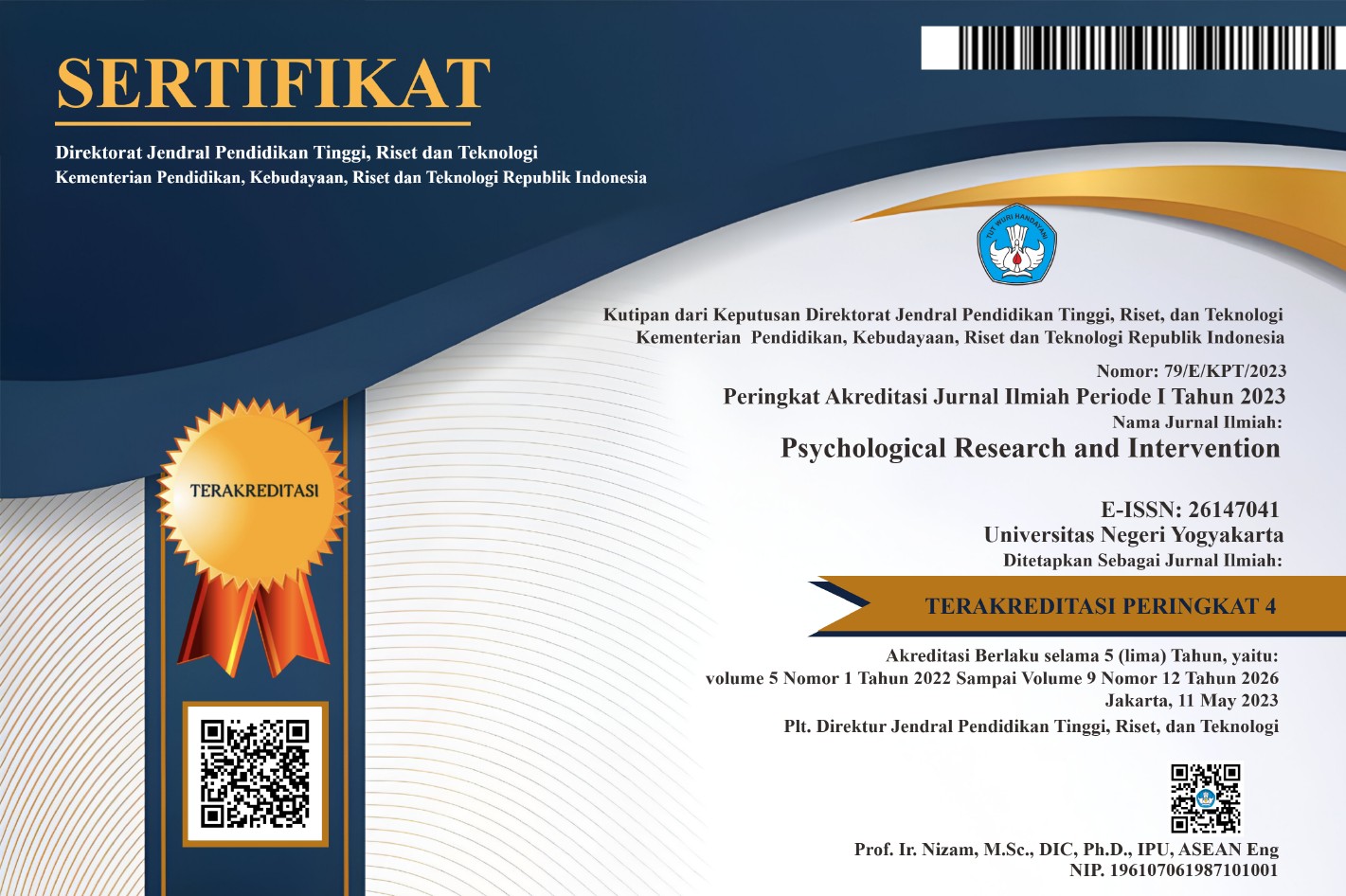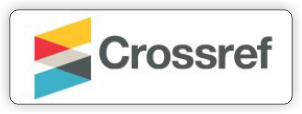The role of internet parenting on internet addiction among adolescents
DOI:
https://doi.org/10.21831/pri.v6i2.70585Keywords:
Internet Parenting, Internet Addiction, AdolescentsAbstract
Various age groups have used the internet, including adolescents. Uncontrolled internet use can lead to psychological problems, such as internet addiction. One of the factors causing internet addiction is the lack of parental mediation in adolescents' internet activities, but some previous studies related to internet parenting showed inconsistent results. This study aims to determine the effect of internet parenting on internet addiction among junior high school adolescents in Yogyakarta. It is a quantitative survey study using the Indonesian version of the Internet Addiction Test scale (a=0.888) and the Internet Parenting scale (a=0.921). The data were collected from 171 junior high school students in Yogyakarta (ages 12-17) by online questionnaire and analyzed using linear regression in JASP 0.17.1. The research findings show an insignificant predictor of internet parenting to internet addiction (F=0.045, P=0.833 > 0.05). This shows that although internet parenting may have a role in preventing internet addiction in adolescents, other factors such as peer influence should also be considered in explaining the phenomenon of internet addiction among junior high school adolescents in Yogyakarta.
References
Abd Latief, N. S., & Retnowati, E. (2018). Kesepian Dan Harga Diri Sebagai Prediksi Dari Kecanduan Internet Pada Remaja. Jurnal Ecopsy, 5(3). ttps://doi.org/10.20527/ecopsy.v5i3.5593
Al-Ghiffari, D. F. (2021). Pengaruh Kontrol Diri terhadap Kecanduan Internet pada Mahasiswa Psikologi UIN Malang Angkatan 2017. Universitas Islam Negeri Maulana Malik Ibrahim Malang.
Ariani, G. A. A. P. P., Suryani, & Hernawaty, T. (2018). Relationship Between Academic Stress, Family and Peer Attachment with Internet Addiction in Adolescents. Padjajaran Nursing Journal, 6(3), 215–226.
Ashari, Z. M., Hassan, H. S., Zainudin, N. F., & Jumaat, N. F. (2022). Sains Humanika Internet Addiction and Its Relationship with Happiness and Life Satisfaction among University Students. 2, 1–8. https://doi.org/10.11113/sh.v14n3-2.2012
Asosiasi Penyelenggara Jasa Internet Indonesia. (2022). Profil Internet Indonesia 2022. Apji. or. Od, 1–104. apji.or.id.
Ayamiseba, I. S. (2016). Hubungan Antara Loneliness Dan Internet Addiction. Universitas Kristen Satya Wacana Salatiga.
Benrazavi, R., Teimouri, M., & Griffiths, M. D. (2015). Utility of parental mediation model on youth's problematic online gaming. International Journal of Mental Health and Addiction, 13(6), 712–727. doi:10.1007/s11469-015-9561-2
Casey, B. J. (2015). Beyond Simple Models of Self-Control to Circuit-Based Accounts of Adolescent Behavior. The Annual Review of Psychology, 66(6), 1–25. https://doi.org/10.1146/annurev-psych-010814-015156
Cerniglia, L., Zoratto, F., Cimino, S., Laviola, G., Ammaniti, M., & Adriani, W. (2017). Internet Addiction in Adolescence: Neurobiological, psychosocial and clinical issues. Neuroscience & Biobehavioral Reviews, 76, 174–184. doi:10.1016/j.neubiorev.2016.12.024.
Chang, F.-C., Chiu, C.-H., Miao, N.-F., Chen, P.-H., Lee, C.-M., Chiang, J.-T., & Pan, Y.-C. (2015). The relationship between parental mediation and Internet addiction among adolescents, and the association with cyberbullying and depression. Comprehensive Psychiatry, 57, 21–28. doi:10.1016/j.comppsych.2014.11.013.
Chung, S., Lee, J., & Lee, H. K. (2019). Personal Factors, Internet Characteristics, and Environmental Factors Contributing to Adolescent Internet Addiction: A Public Health Perspective. International Journal of Environmental Research and Public Health, 16, 2–16. https://doi.org/10.3390/ijerph16234635
Creswell, J. W., & Creswell, J. D. (2018). Research Design: Qualitative, Quantitative, and Mixed Methods Approaches, Fifth Edition. London: SAGE Publicational.
Destari, M. R. (2022). Internet Parenting sebagai Kontrol dalam Penggunaan Internet pada Remaja. JKKP (Jurnal Kesejahteraan Keluarga dan Pendidikan), 9(01), 31-42.
Gayatri, G., Rusadi, U., Meiningsih, S., Mahmudah, D., Sari, D., &
Nugroho, A. C. (2015). Digital Citizenship Safety Among Children And Adolescents in Indonesia. Jurnal Penelitian Dan Pengembangan Komunikasi Dan Informatika, 6(1), 1–18.
Hanifah, N. (2018). Pengaruh Internet Parenting terhadap Aksesibilitas Pornografi Remaja. Doctoral dissertation, Universitas Negeri Jakarta.
Huang, S., Lai, X., Li, Y., Wang, W., Zhao, X., Dai, X., Wang, H., & Wang,
Y. (2023). Does parental media mediation make a difference for adolescents? Evidence from an empirical cohort study of parent-adolescent dyads. Heliyon, 9(4). https://doi.org/10.1016/j.heliyon.2023.e14897
Ibrahim, M. (2019). Relationship Internet Addiction With External Factors in Adolescent Age 15-18 Years At Senior High School Baleendah. Jurnal Keperawatan Padjadjaran, 7(3), 257–267.
Iqbal, S., Zakar, R., & Fischer, F. (2021). Predictors of parental mediation in teenagers' internet use: a cross-sectional study of female caregivers in Lahore, Pakistan. BMC Public Health, 21(1). doi:10.1186/s12889-021-10349-z
Kawabe, K., Horiuchi, F., Ochi, M., Oka, Y., & Ueno, S. (2016). Internet Addiction: Prevalence and Relation with Mental States in Adolescents. Psychiatry and Clinical Neurosciences, 70(9), 405–412. doi:10.1111/pcn.12402
Kominfo. (2014). Riset Kominfo dan UNICEF Mengenai Perilaku Anak dan Remaja Dalam Menggunakan Internet. Diakses pada 16 Maret 2023, dari Kementerian Komunikasi dan Informatika (kominfo.go.id).
Koob, G. F., & Volkow, N. D. (2016). Neurobiology of addiction: a neurocircuitry analysis. The Lancet. Psychiatry, 3(8), 760–773. https://doi.org/10.1016/S2215-0366(16)00104-8
Kurniasanti, K. S., Assandi, P., Ismail, R. I., Nasrun, M. W. S., & Wiguna, T. (2019). Internet addiction: A new addiction? Medical Journal of Indonesia, 28(1), 82–91. https://doi.org/10.13181/mji.v28i1.2752
Kuss, D., Griffiths, M., Karila, L., & Billieux, J. (2014). Internet Addiction: A Systematic Review of Epidemiological Research for the Last Decade. Current Pharmaceutical Design, 20(25), 4026–4052. https://doi.org/10.2174/13816128113199990617
Lee, E. J., & Ogbolu, Y. (2018). Does parental control work with smartphone addiction?: A cross-sectional study of children in South Korea. Journal of Addictions Nursing, 29(2), 128-138. DOI: 10.1097/JAN.0000000000000222
Li, C., Dang, J., Zhang, X., Zhang, Q., & Guo, J. (2014). Internet addiction among Chinese adolescents: The effect of parental behavior and self-control. Computers in Human Behavior, 41, 1–7. doi:10.1016/j.chb.2014.09.001
Li, X., Ding, Y., Bai, X., & Liu, L. (2022). Associations between parental mediation and adolescents' internet addiction: The role of parent-child relationship and adolescents' grades. Frontiers in Psychology, 13, 1061631. https://doi.org/10.3389/fpsyg.2022.1061631
Livingstone, S. & Helsper, E. (2008). Parental mediation and children's Internet use. Journal of broadcasting & electronic media, 52 (4), 581-599. doi: 10.1080/08838150802437396
Mathias, P. M., & Singh, K. (2023). Evolution In The Role Of Parental Mediation From Traditional Media To Digital Media Usage In Children: A Review Paper. Journal of Positive School Psychology, 989-997.
Muche, H., & Asrese, K. (2021). Prevalence of Internet Addiction and Associated Factors Among Students in an Ethiopian University: A Cross-Sectional Study. Journal of Social Work Practice in the Addictions, 00(00), 1–17. https://doi.org/10.1080/1533256X.2021.1903681
Nielsen, P., Favez, N., Liddle, H., & Rigter, H. (2019). Linking parental mediation practices to adolescents' problematic online screen use: A systematic literature review. Journal of Behavioral Addictions, 1–15. doi:10.1556/2006.8.2019.61
Pratiwi, R., & Afiatin, T. (2021). Peranan mediasi orang tua terhadap kecanduan internet pada remaja: Harga diri sebagai mediator. Jurnal Psikologi Sosial, 19(1), 69-75.
Prasojo, R. A., Maharani, D. A., & Hasanuddin, M. O. (2018). Mengujikan Internet Addiction Test (IAT) ke Responden Indonesia. INA-Rxiv. https://doi.org/10.31227/osf.io/7ag4w
Putri, T. H., Priyono, D., Keperawatan, P. S., Kedokteran, F., Tanjungpura, U., Hadari, J. H., & Bansir, N. (2021). Kecanduan internet pada anak sekolah selama pandemi covid-19. Jurnal Keperawatan Jiwa (JKJ): Persatuan Perawat Nasional Indonesia, 9(4), 745-752.
Reiner, I., Tibubos, A. N., Hardt, J., Mí¼ller, K., Wí¶lfling, K., & Beutel, M. E. (2017). Peer Attachment, Specific Patterns of Internet Use and Problematic Internet Use in Male and Female Adolescents. European Child and Adolescent Psychiatry, 26(10), 1257–1268. https://doi.org/10.1007/s00787-017-0984-0
Rich, M., Tsappis, M., & Kavanaugh, J. R. (2017). Problematic interactive media use among children and adolescents: Addiction, compulsion, or syndrome? In K. S. Young & C. N. de Abreu (Eds.), Internet addiction in children and adolescents: Risk factors, assessment, and treatment (pp. 3–28). Springer Publishing Company. https://doi.org/10.1891/9780826133731.0001
Salicetia, F. (2015). Internet Addiction Disorder (IAD). Procedia - Social and Behavioral Sciences, 191, 1372–1376. https://doi.org/10.1016/j.sbspro.2015.04.292
Santrock, J. W. (2019). Life Span Development (Seventeen). New York: McGraw Hill Education.
Sari, A. P., Ilyas, A., & Ifdil, I. (2017). Tingkat Kecanduan Internet pada Remaja Awal. Jurnal Penelitian Pendidikan Indonesia, 3(2), 110–117.
Sasson, H., & Mesch, G. (2014). Parental Mediation, Peer Norms and Risky Online Behavior Among Adolescents. Computers in Human Behavior, 33, 32–38. https://doi.org/10.1016/j.chb.2013.12.025
Setiawati, F. A. (2017). Statistika Terapan Untuk Penelitian Pendidikan dan Sosial. Parama Publishing.
Setiawati, Y., Hartanti, D. T., Husada, D., Irwanto, I., Ardani, I. G. A. I., & Nazmuddin, M. (2021). Relationship between Paternal and Maternal Parenting Style with Internet Addiction Level of Adolescents. Iranian Journal of Psychiatry, 16(4), 438–443. https://doi.org/10.18502/ijps.v16i4.7231
Thiyameira, A. Z. (2018). Hubungan Antara Kecanduan Internet Dengan Kecemasan Remaja Usia 12-15 Tahun Di 4 Sekolah Menengah Pertama (SMP) Wilayah Kecamatan Kramat Jati Jakarta Timur, DKI Jakarta Tahun 2018. Doctoral dissertation, Universitas Binawan.
Wang, Y., Wu, A. M. S., & Lau, J. T. F. (2016). The Health Belief Model and Number of Peers with Internet Addiction as Interrelated Factors of Internet Addiction Among Secondary School Students in Hong Kong. BMC Public Health, 16, 1–13. https://doi.org/10.1186/s12889-016-2947-7
Wu, C.S.T., Wong, H.T., Yu, K.F. et al. Parenting approaches, family functionality, and internet addiction among Hong Kong adolescents. BMC Pediatr 16, 130 (2016). https://doi.org/10.1186/s12887-016-0666-y
Xu, X., Han, W., & Liu, Q. (2023). Peer Pressure and Adolescent Mobile Social Media Addiction: Moderation Analysis of Self-Esteem and Self-Concept. Frontiers Public Health, 1–9. https://doi.org/10.3389/fpubh.2023.1115661
Yang, S. C., & Tung, C.-J. (2007). Comparison of Internet Addicts and Non-Addicts in Taiwanese High School. Computers in Human Behavior, 23(1), 79–96. doi:10.1016/j.chb.2004.03.037
Young, K. S. (1996). Psychology of Computer Use: XL. Addictive Use of the Internet: A Case That Breaks the Stereotype. Psychological Reports, 79(3), 899–902. doi:10.2466/pr0.1996.79.3.899
Zhou, P., Zhang, C., Liu, J., & Wang, Z. (2017). The Relationship Between Resilience and Internet Addiction: A Multiple Mediation Model Through Peer Relationship and Depression. Cyberpsychology, Behavior, and Social Networking, 20(10), 634–639. https://doi.org/10.1089/cyber.2017.0319












